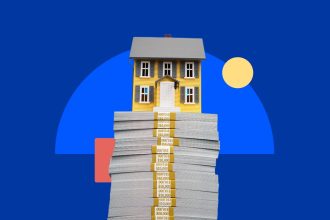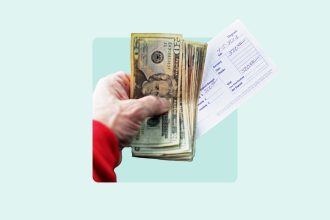Images by GettyImages; Illustration by Hunter Newton/Bankrate
Key takeaways
- Some 19 percent of homeowners surveyed say they’ve taken on debt to pay for maintenance and other hidden costs of homeownership, according to a Bankrate survey.
- Fully 24 percent say they’ve set aside money specifically for home repairs and maintenance.
- If you own a home, surprise repairs are a financial fact of life. You can prepare for the inevitable by saving, understanding the lifespan of your home’s features and maintaining an adequate homeowners insurance policy.
Jim Hall loves his home on a spacious 1.6-acre lot in Newport News, Virginia. But when it became clear that his heating and air conditioning system was poorly designed and failing, the retiree found himself facing a $42,000 tab to install two new units and all new ductwork.
“It was more than I expected to or wanted to spend,” says Hall.
The American housing boom keeps marching on, and homeowners might consider themselves fortunate to be on the property ladder. Still, homeownership comes with hidden costs — and the pandemic-driven factors of inflation, rising materials costs and labor shortages have raised the stakes for homeowners juggling paying the mortgage and keeping their homes in tip-top shape.
How are homeowners paying for surprise costs?
Emergency savings accounts and rainy-day funds provide self-insurance against the inevitable expenses.
— Mark Hamrick, Bankrate Senior Economic Analyst
Fully 24 percent of American homeowners say they have set money aside for repairs and maintenance on their homes, according to a Bankrate survey.
Indeed, the best way to absorb unexpected bills is to stash money in a high-yield savings account.
“When it comes to paying the inevitable expenses associated with homeownership, prioritizing savings is the key to avoiding a domino effect of further borrowing costs,” says Mark Hamrick, Bankrate’s chief economic analyst.
That’s not always a realistic solution, however. In Hall’s case, when he was hit with a big bill for home repairs, he was facing other expenses, including car repairs and his grandson’s tuition.
Hall paid for the work with a financing package that charged no interest for a year. Once the no-interest period ran out, Hall paid off the balance by taking a home equity loan — a type of second mortgage — from Rocket Mortgage.
The move was one familiar to many American homeowners. Fully 19 percent say they have taken on debt to cover the costs of unexpected home repairs, according to the Bankrate survey. Some 31 percent of Generation Z and 26 percent of millennials have borrowed to cover home repairs, and 31 percent of parents with children younger than 18 have taken on debt.
Of the 19 percent of homeowners who have taken on some form of debt to cover the hidden costs of homeownership:
- 60 percent say they took on credit card debt
- 33 percent got personal loans
- 25 percent took second mortgages.
(Note: Respondents could choose more than one form of debt.)
Common unexpected costs of homeownership
- Roof replacement: $9,392
- HVAC installation or replacement: $7,000
- Foundation repair: $5,017
- Whole-home termite treatment: $2,500
- Water heater installation/replacement: $1,312
Source:
National averages from HomeAdvisor
Taking on debt for home repairs isn’t a terrible idea — the repairs are designed to improve the functionality and value of your home for many years, so the benefits are certainly longer-lasting than borrowing to take a vacation.
Still, rising interest rates have increased the financial pain associated with borrowing to fund home repairs. The average rate on a home equity line of credit was 9.17 percent as of May 15, while the typical rate on a home equity loan was 8.66 percent, according to Bankrate’s national survey of lenders. Meanwhile, running a credit card balance means paying an interest rate north of 20 percent.
That’s why Anthony Robinson, a property investor, aims to build a cash cushion for his properties. He tries to build an emergency savings of 5 percent to 7 percent of the value of his homes.
The approach paid off last year, when hail damaged a rental house he owns in Greensboro, North Carolina. The storm caused roof damage that cost more than $5,000 to repair. However, after insurance coverage, Robinson was on the hook for only $1,000.
The episode was a reminder to keep fattening up his savings account.
“There’s always going to be one-offs,” says Robinson, a marketing manager at Thumbtack, a site that helps homeowners manage their properties.
While insurance settlements and home equity loans can help in a pinch, nothing gives homeowners peace of mind like cash in the bank, says Hamrick of Bankrate.
“The hidden costs of homeownership serve as another in a long string of arguments in favor of prioritizing savings,” says Hamrick. “Emergency savings accounts and rainy-day funds provide self-insurance against the inevitable expenses that are simply just part of life, including for homeowners.”
Tips to budget for unexpected home repairs
- Set aside some cash. How much? There’s no standard, but a broad rule of thumb says you should target 1 percent to 4 percent of the home’s value. For a $400,000 property, something between $4,000 and $16,000 a year is in the ballpark. Of course, the repair bills depend in part on the age and condition of the home. A newly built house shouldn’t need major fixes for a decade, while a 100-year-old home probably needs significant work every year.
- Take a look at the age of your home’s features. Heating and air conditioning systems can last 10 to 12 years, while roofs can survive for 20 years or longer. Knowing how much life is left in your home’s systems can help you prepare.
- Don’t forget about insurance. While your homeowners insurance won’t cover routine maintenance and repairs, it might provide a financial lifeline if your unexpected costs are the result of weather or water damage. (Be sure to review your policy so you understand what is and isn’t covered.)
-
Bankrate commissioned YouGov Plc to conduct the survey. All figures, unless otherwise stated, are from YouGov Plc. The total sample size was 2,408 U.S. adults, among whom 1,270 were homeowners. Fieldwork was undertaken between April 15-17, 2024. The survey was carried out online and meets rigorous quality standards. It employed a non-probability-based sample using both quotas upfront during collection and then a weighting scheme on the back end designed and proven to provide nationally representative results.
Read the full article here
















